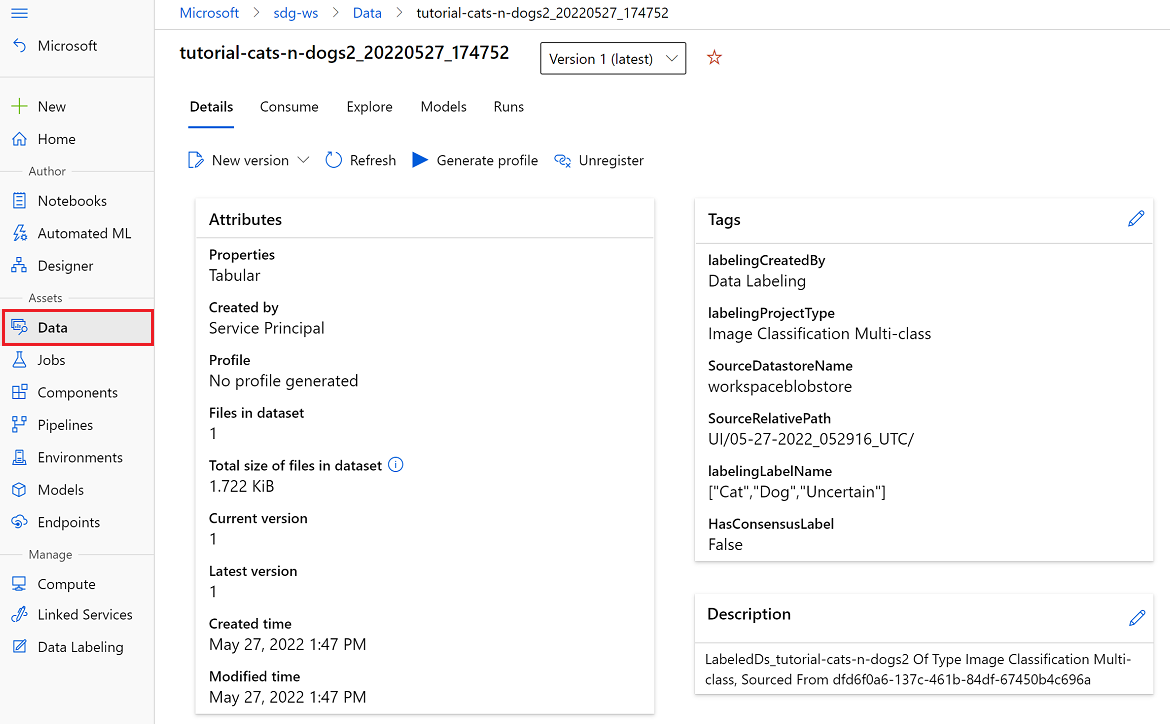建立和探索具有標籤的 Azure Machine Learning 資料集
在本文中,您將了解如何從 Azure Machine Learning 資料標記專案匯出資料標籤,並將其載入為流行的常用格式,例如適用於資料探索的 pandas 資料框架。
什麼是具有標籤的資料集
具有標籤的 Azure Machine Learning 資料集,即稱為標籤資料集。 這些特定的資料集,是具有專用標籤資料行的 TabularDataset,並且僅建立作為 Azure Machine Learning 資料標記專案的輸出。 建立資料標記專案進行影像標記或文字標記。 Machine Learning 支援用於影像分類的資料標記專案 (多標籤或多類別),以及搭配使用週框方塊的物體識別。
必要條件
- Azure 訂用帳戶。 如果您沒有 Azure 訂用帳戶,請在開始前建立免費帳戶 。
- 適用於 Python 的 Azure Machine Learning SDK,或 Azure Machine Learning Studio 的存取權。
- Machine Learning 工作區。 請參閱建立工作區資源。
- Azure Machine Learning 資料標記專案的存取權。 如果您沒有標記專案,請首先建立一個標記專案進行影像標記或文字標記。
匯出資料標籤
當您完成資料標記專案後,即可從標記專案匯出標籤資料。 這麼做可讓您同時擷取資料和其標籤的參考,並以 COCO 格式 或 Azure Machine Learning 資料集來匯出這些資料。
在標籤專案的 [專案詳細資料] 頁面上使用 [匯出] 按鈕。
![工作室 UI 中的 [匯入] 按鈕](media/how-to-use-labeled-dataset/export-button.png?view=azureml-api-1)
COCO
COCO 檔案會建立在 Azure Machine Learning 工作區的預設 Blob 存放區中,而其所在的資料夾位於 export/coco 內。
注意
在物件偵測專案中,會將 COCO 檔案中匯出的 bbox:[x,y,width,height] 值正規化。 它們會調整為 1。 範例:在 640x480 的像素影像中,位於 (10, 10) 的周框方塊 (寬度為 30 像素,高度為 60 像素) 將標註為 (0.015625, 0.02083, 0.046875, 0.125)。 由於座標會正規化,因此針對所有影像,其會將「寬度」和「高度」顯示為 '0.0'。 您可以使用 Python 程式庫 (例如 OpenCV 或 Pillow (PIL)) 來取得實際的寬度和高度。
Azure Machine Learning 資料集
您可以在 Azure Machine Learning Studio 的 [資料集] 區段中,存取已匯出的 Azure Machine Learning 資料集。 資料集詳細資料頁面也會提供從 Python 存取標籤的程式碼範例。

提示
一旦將已標記資料匯出至 Azure Machine Learning 資料集,您就可以使用 AutoML,來建置已標記資料上定型的電腦視覺模型。 深入了解使用 Python 設定 AutoML 以定型電腦視覺模型
透過 pandas 資料框架探索已標記的資料集
將已標記的資料集載入 pandas 資料框架,以利用熱門的開放原始碼程式庫,透過 azureml-dataprep 類別的 to_pandas_dataframe() 方法進行資料探索。
使用下列殼層命令來安裝類別:
pip install azureml-dataprep
在下列程式碼中,animal_labels 資料集是標記專案先前儲存至工作區的輸出。
匯出的資料集是 TabularDataset。
適用於:  Python SDK azureml v1 (部分機器翻譯)
Python SDK azureml v1 (部分機器翻譯)
import azureml.core
from azureml.core import Dataset, Workspace
# get animal_labels dataset from the workspace
animal_labels = Dataset.get_by_name(workspace, 'animal_labels')
animal_pd = animal_labels.to_pandas_dataframe()
import matplotlib.pyplot as plt
import matplotlib.image as mpimg
#read images from dataset
img = mpimg.imread(animal_pd['image_url'].iloc(0).open())
imgplot = plt.imshow(img)